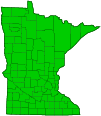common mullein
(Verbascum thapsus ssp. thapsus)
Conservation • Weed • Wetland • Description • Habitat • Ecology • Use • Distribution • Taxonomy
Description |
Common mullein is an exotic, tall, common weed. It is native to Africa, Asia, and Europe. It was first introduced into Virginia in the mid-1700’s as a fish poison. It soon became naturalized and it spread quickly, reaching the Pacific coast by 1876. Common mullein is found in pastures, meadows, woodland openings, roadsides, railroads, vacant lots, and other disturbed sites. It grows under full sun in moderately moist to dry soil. Common mullein is a 12″ to 80″ tall, erect, biennial forb that rises from a deep, stout taproot and fibrous roots. In the first year it produces a basal rosette of large fuzzy leaves. In the second year it produces a single flowering stalk. The basal rosette is often showy and can be up to 40″ in diameter, though it is usually much smaller. Basal leaves are soft to the touch, bluish grayish-green, stalked, oblong or inversely lance-shaped, 4″ to 18″ long, and 1″ to 5″ wide. They are tapered at the base and rounded or tapered at the tip. The upper and lower surfaces are densely covered with gray hairs that are branched at the tip in a star-shaped pattern. The margins are wavy and untoothed or shallowly toothed with rounded teeth. The stems are erect, stout, leafy, and densely covered with gray, star-shaped hairs. They are unbranched below the middle but sometimes branched near the top. Lower stem leaves are alternate, stalked, oblong to oblong egg-shaped, and mostly untoothed. The blade continues down the leaf stalk as wings. They are otherwise similar to basal leaves. Stem leaves become progressively smaller and shorter stalked as they ascend the stem. Upper stem leaves are stalkless with the leaf blade continuing down the stem to the next leaf below as narrow wings. The inflorescence is a spike of many flowers at the end of the stem. The spike is densely flowered, cylinder-shaped, 8″ to 20″ long, and ¾″ to 1¼″ wide. It continues to lengthen as the season progresses. It is unbranched but there is sometimes more than one spike. The flowers mostly appear in short-stalked clusters (fascicles). Each fascicle is few-flowered and is subtended by a leaf-like or scale-like, densely hairy appendage (bract). The flowers are ⅜″ to 1″ in diameter. There are 5 sepals, 5 petals, 5 stamens, and 1 style. The sepals (calyx) are green and densely hairy. They are fused at the base into an approximately 1 ⁄16″ long tube, then separated into 5 lobes. The calyx lobes are lance-shaped, 3 ⁄16″ to ¼″ long, and 1 ⁄16″ to ⅛″ wide at the base. They are shorter than the subtending bracts. The petals are yellow, fused at the base into an approximately 5 ⁄16″ long tube, then separated into 5 rounded, spreading lobes. The 3 lower lobes are somewhat longer than the 2 upper. The stamens have yellow filaments and orange anthers, and are unequal in length. The 3 upper stamens have short, densely hairy filaments and short anthers. The 2 lower stamens have much longer, hairless or nearly hairless filaments and long anthers. The style is green. The fruit is a broadly egg-shaped, ⅜″ long, hairy capsule with many seeds. The style persists in fruit and is as long as the capsule. The seeds are brown, tiny, and ridged. They are dispersed by wind. The leaves fall away as the fruits ripen but the stalk and fruiting head persist through the winter. |
Height |
12″ to 80″ |
Flower Color |
Yellow |
Similar Species |
| No similar species |
Habitat |
Moderate moisture to dry. Pastures, meadows, woodland openings, roadsides, railroads, vacant lots, and other disturbed sites. Full sun. |
Ecology |
Flowering |
June to October |
Pests and Diseases |
|
Use |
|
Distribution |
||
|
Sources |
|
| 12/2/2024 | ||
Nativity |
||
Native of Africa, Asia, and Europe. Introduced and naturalized in North America. |
||
Occurrence |
||
Common and abundant |
||
Taxonomy |
|
Kingdom |
|
Division |
Tracheophyta (Vascular Plants) |
Subdivision |
Spermatophytina (Seed Plants) |
Class |
|
Order |
Lamiales (Mints, Plantains, Olives, and Allies) |
Family |
Scrophulariaceae (figwort) |
Tribe |
Scrophularieae |
Genus |
Verbascum (mulleins) |
Species |
Verbascum thapsus (common mullein) |
|
|
There are three subspecies of Verbascum thapsus. Only ssp. thaspus occurs in North America. |
|
Subordinate Taxa |
|
|
|
Synonyms |
|
Thapsus barbatus Verbascum bicolle Verbascum blattaria Verbascum indicum Verbascum linnaei Verbascum phlomoides Verbascum simplex var. dyris Verbascum subviride Verbascum thapsiforme |
|
Common Names |
|
Aaron’s-rod beggar’s blanket big taper blanketweed candlewick plant Charmin of the woods common mullein cowboy’s toilet paper flannel mullein flannel plant flannelleaf flannelplant great mullein grey mullein hag taper mullein toilet paper plant torches velvet dock velvet-dock velvet plant velvetplant wild tobacco woolly mullein |
|
Glossary
Bract
Modified leaf at the base of a flower stalk, flower cluster, or inflorescence.
Calyx
The group of outer floral leaves (sepals) below the petals, occasionally forming a tube.
Fascicle
A small bundle or cluster, often sheathed at the base, as with pine needles.
Filament
On plants: The thread-like stalk of a stamen which supports the anther. On Lepidoptera: One of a pair of long, thin, fleshy extensions extending from the thorax, and sometimes also from the abdomen, of a caterpillar.
Wing
A thin, flat, membranous, usually transparent appendage on the margin of a structure.
Visitor Photos |
||
Share your photo of this plant. |
||
This button not working for you? |
||
Alfredo Colon |
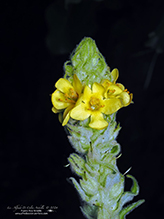 |
Natasha Hurston |
||
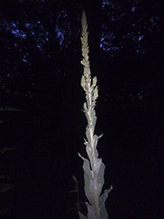 |
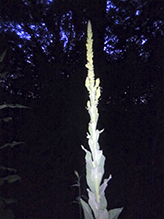 |
|
MinnesotaSeasons.com Photos |
||
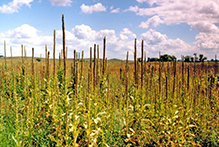 |
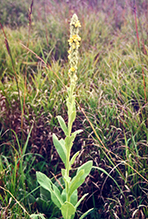 |
|
Habitat |
||
|
||
|
||
|
Plant |
|
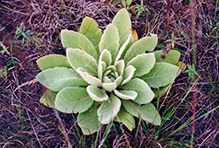 |
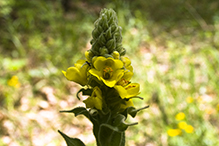 |
|
First-year rosette |
Inflorescence |
|
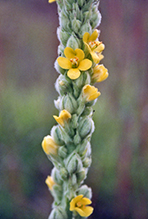 |
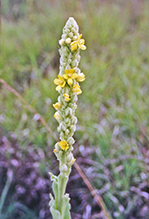 |
|
Inflorescence |
Inflorescence |
|
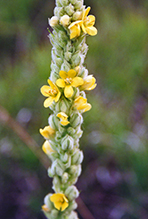 |
||
Inflorescence |
|
|
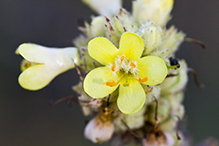 |
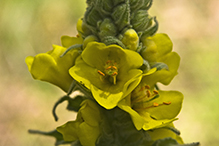 |
|
Flower |
Flower |

Slideshows |
Great Mullein |
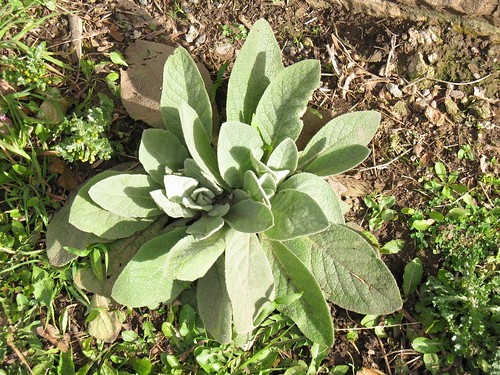
|
About
Great Mullein (Verbascum thapsus). |
Common Mullein |
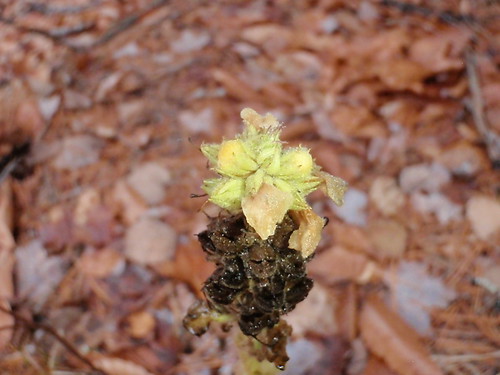
|
About
(Verbascum thapsus) |
Verbascum thapsus COMMON MULLEIN |
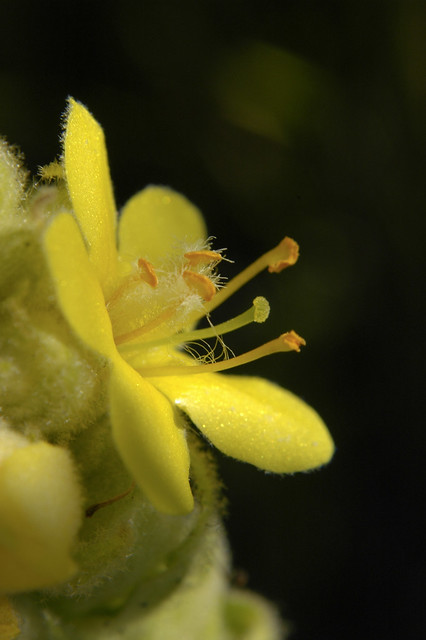
|
Plant portrait - Common mullein (Verbascum thapsus) |
About
Published on Feb 6, 2013 A detailed look at the life cycle of Common mullein (Verbascum thapsus). These images can aid in identifying this plant during all seasons of the year. |

Visitor Videos |
||
Share your video of this plant. |
||
This button not working for you? |
||
|
Other Videos |
||
Mullein [Verbascum Thapsus] Identification |
About
Published on Jul 31, 2013 Krik of Black Owl Outdoors identifies and extremely useful plant, Mullein [Verbascum Thapsus] |
Ontario Weeds - Common mullein, Verbascum thapsus L. |
About
Uploaded on Dec 18, 2010 Common mullein, Verbascum thapsus L. as found in the " Ontario Weeds" publication published by the government of Ontario. http://www.omafra.gov.on.ca/english/crops/facts/ontweeds/common_mullein.htm This plant smoked is excellent for the lungs and helps removes fluids in the lungs also. I have tried it personally and it works. |
Great Mullein (Verbascum Thapsus) / Common Mullein - 2012-06-20 |
About
Published on Jun 22, 2012 Verbascum thapsus (Great or Common Mullein) is a species of mullein. -------------- |
Weed of the Week #825 - Common Mullein (Air Date 1/26/14) |
About
Published on Jan 30, 2014 It's our Weed of the Week, Common Mullein. |

Visitor Sightings |
||
Report a sighting of this plant. |
||
This button not working for you? |
||
Alfredo Colon |
Location: Albany, NY |
 |
| Natasha Hurston 6/22/2023 8pm or 8:33pm Thursday |
Location: Oxford, Alabama are they poisonous around here if so please email me back |
|
| John Valo 6/24/2023 |
Common mullein seeds are toxic. The plant contains rotenone and coumarin, which the US Food and Drug Administration classifies as potentially dangerous. However, parts of the plant are safe for consumption in reasonable quantities. Tea was made from the roots and white clover flowers to treat asthma. Another tea was made from the leaves and flowers to treat a variety of respiratory and gastrointestinal ailments. However, the teas should be strained before consuming. Fuzz from the leaves may irritate sensitive skin and throat membranes. — Adapted from Edible and Medicinal Plants of Canada, MacKinnon et al., 2009, Lone Pine Publishing |
|
| Brian Stock 6/29/2020 |
Location: Richfield, MN Single common mullein plant growing in my front flower bed in Richfield, MN. Didn't know if I had planted it or not until I looked up what it was. Will remove it tomorrow. |
|
MinnesotaSeasons.com Sightings |
||
Avon Hills Forest SNA, North Unit Beaver Creek Valley State Park Bertram Chain of Lakes Regional Park Cannon River Turtle Preserve SNA Carpenter St. Croix Valley Nature Center Carver Highlands WMA, South Unit Cedar Creek Ecosystem Science Reserve Charles A. Lindbergh State Park Clifton E. French Regional Park Clinton Falls Dwarf Trout Lily SNA Felton Prairie SNA, Bicentennial Unit Forestville/Mystery Cave State Park Hardscrabble Woods / MG Tusler Sanctuary John Peter Hoffman Spring Brook Valley WMA Kellogg Weaver Dunes SNA, Kellogg Weaver Unit Kellogg Weaver Dunes SNA, Weaver Dunes Unit Lake Alexander Woods SNA, South Unit Mary Schmidt Crawford Woods SNA Minnesota Valley NWR, Black Dog Unit Minnesota Valley NWR, Long Meadow Lake Unit Minnesota Valley NWR, Louisville Swamp Unit Minnesota Valley NWR, Rapids Lake Unit Minnesota Valley NWR, Wilkie Unit Minnesota Valley State Recreation Area, Lawrence Unit Northern Tallgrass Prairie NWR, Rengstorf Unit Northern Tallgrass Prairie NWR, Touch the Sky Prairie Unit P.N. and G.M. Nelson Wildlife Sanctuary Pembina Trail Preserve SNA, Crookston Prairie Unit Prairie Creek WMA, Koester Prairie Unit Robert Ney Memorial Park Reserve Sand Prairie Wildlife Management and Environmental Education Area |

|
Created: Last Updated: © MinnesotaSeasons.com. All rights reserved. |
